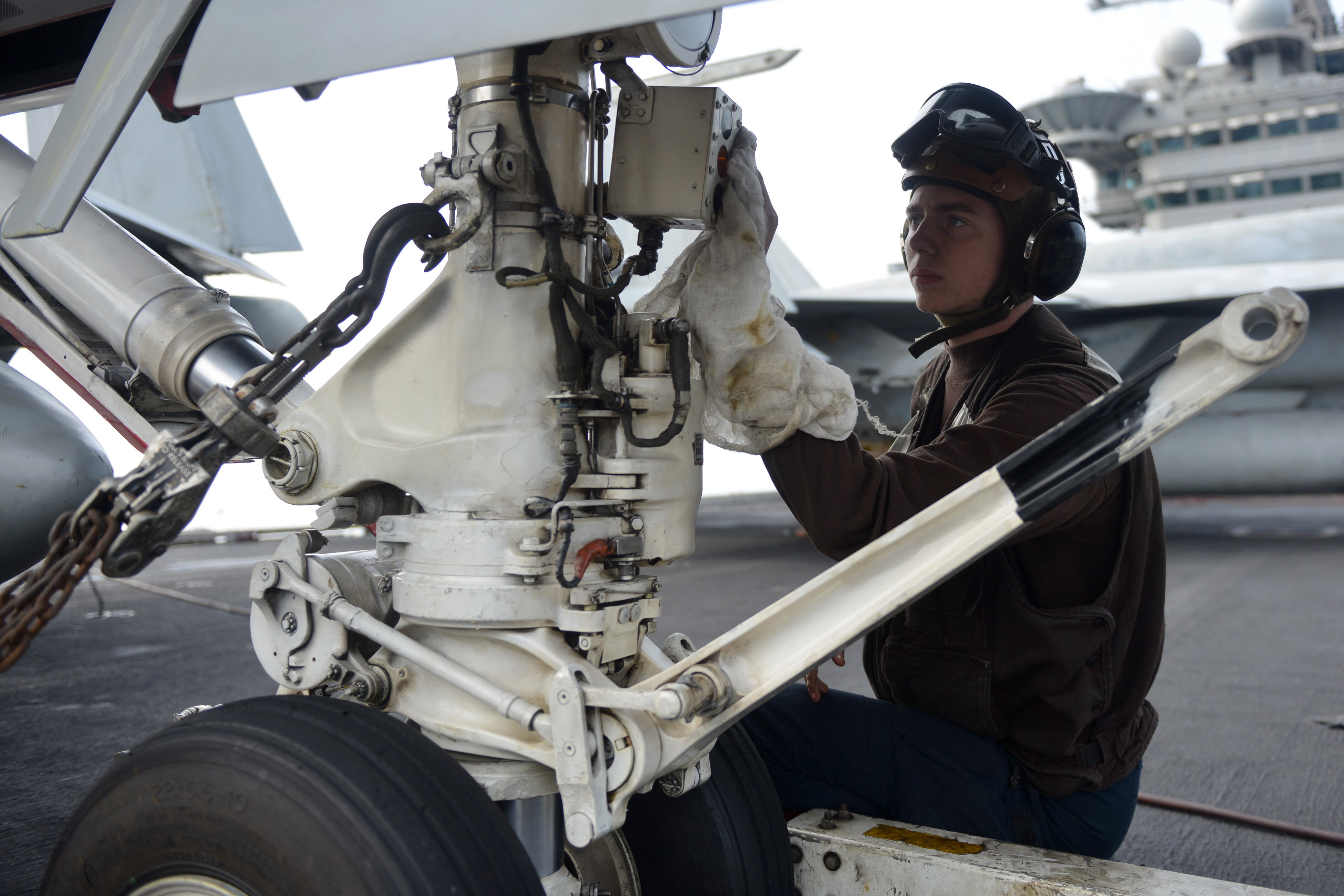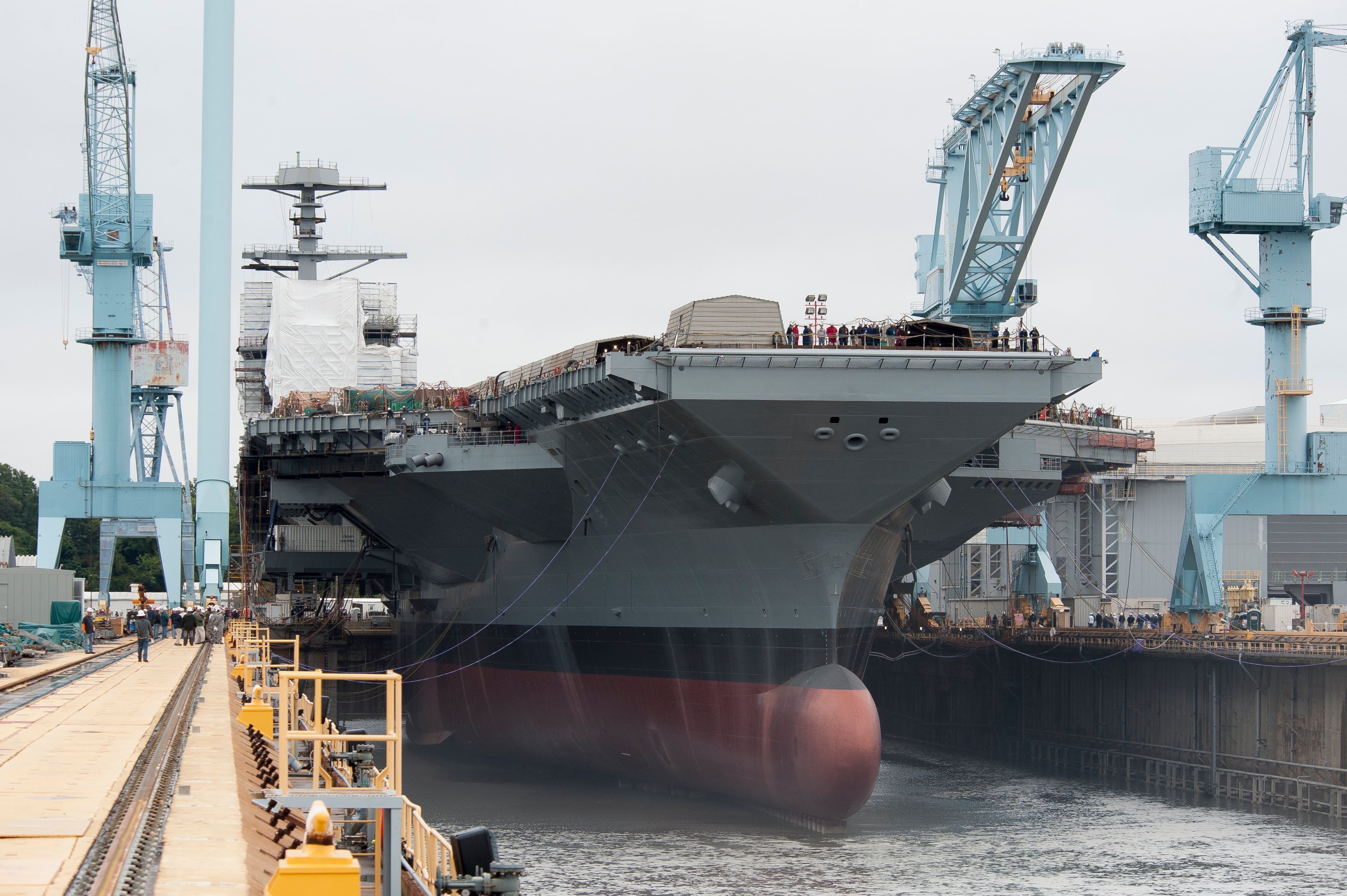The Navy is in the midst of sweeping huge changes in aviation, particularly in regard to with the future carrier air wing.
As engineers continue to develop the F-35C Lightning II, the carrier variant of the stealth aircraft that has suffered repeated delays, service officials are trying to ensure an adequate number of F/A-18 Hornets and Super Hornets strike fighters are available to operate at sea. In addition, the Navy is Officials are working to manage the number of strike fighters operating Shat sea as the F-35C Lightning II continues development, while bringing on a new early warning aircraft and beginning the shift from a twin-engine cargo aircraft for jet-based carrier onboard delivery to the tiltrotor tiltoror aircraft now flown by Marines.
Meanwhile, the helicopter community is retiring transitioning out of two older H-60 aircraft and either shuttering some squadrons while or transitioning othersthem to newer models.
The first-in-class carrier Gerald R. Ford, with its impressive array of technological advancements, appears to be on pace for its March 2016 delivery, but nagging issues with the launch and recovery systems continue to produce major headaches.
Digital Show Daily: Complete coverage from the Navy League Sea-Air-Space Exposition
And finally, with the successful conclusion of the Unmanned Combat Air System Demonstration program, the Navy is trying to decide what its next steps will be in unmanned carrier aviation.
A brief look at where these programs stand, This is where those programs stand, and what to expect in the months and years ahead:look out for in the future.
New aircraft
The March 11 deployment of the carrier Theodore Roosevelt marked a historic first and last in the world of rotors and propellers. It is the first deployment of the E-2D Advanced Hawkeye for battle management command and control, and the last deployment in which a Hhelicopter Aanti-Ssubmarine Ssquadron flies the SH-60F and H Seahawk models. Upon return, the HS-11 Dragon Slayers will transition into a helicopter sea combat squadron and fly the MH-60S.
The C-2A Greyhound is also on the path to retirement as well as the carrier's primary logistics aircraft. News recently broke that tThe Navy plans for the V-22 Osprey to assume its role in carrier onboard delivery role in coming years. The Navy inIn early January, the Navy set an initial buy of four tiltrotors annually from fiscal 2018 to 2020. The fleet's 35 Greyhounds are expected to keep flying until the mid-2020s.
The first shipboard operational test period for the F-35B, the Marine Corps' jump-jet version of the jJoint sStrike fFighter, will take place May 18 to 30 aboard the amphibious assault ship Wasp. Six of the short take-off and vertical landing jets will participate. Twenty-one alterations were required to equip the Wasp for regular operation of the aircraft, according to Matt Leonard, spokesman for Naval Sea Systems Command. Each alteration will be made on all L-class ships during planned availabilities and in line during construction of on new construction ships in advance of F-35B arrival.
Strike fighter gaps
Chief of Naval Operations Adm. Jon Greenert testified on Capitol Hill in March that the Navy is looking at a gap of 104 strike fighter aircraft this year, and predicteding that number could climb to 134 by 2020.

Aviation Structural Mechanic Airman Zechariah Eger performs maintenance on an F/A-18C Hornet aboard the aircraft carrier Harry S. Truman. The Navy must push its legacy Hornets past their scheduled airframe life.
Photo Credit: MC3 Blagoj B. Petkovski/Navy
It's a domino effect caused by delays in the joint strike fighter program, which was originally scheduled to field the carrier-based F-35C in the early 2010s.
As a result. the Navy has had to push its legacy F/A-18 Hornets, in the A through D variants that are also known as "legacy" Hornets, A-D aircraft past their scheduled airframe life, forcing the jets into depots to extend their flying time from 6,000 to 10,000 hours.
"For the first time in history, naval aviation is maintaining three type-model series in the same mission area, F/A-18 legacy, Super Hornets and F-35," Vice Adm. Paul Grosklags, assistant secretary of the Navy for research, development and acquisitions, told the Senate Armed Services Committee in March.
As those legacy Hornets have come out of service for upgrades, it's put more pressure on the newer F/A-18E/F Super Hornets, eating up their flying hours at a quicker clip and forcing another round of service extensions.
The Navy envisions phasing out the legacy Hornets as the F-35 comes online, keeping Super Hornets on until about 2030. But since they're working so hard now, the F/A-18E/Fs will need a service life extension from 6,000 to 9,000 hours in the mid-2020s, Rear Adm. Michael Manazir, director of air warfare, testified in March.
Extending the legacy Hornets has taught the Navy what to expect, he said, and this time they are prepared for the kinds of repairs the Super Hornets will need.
"...We have learned, we did not do an early enough service-life extension program assessment of the F/A-18A-C. So we found ourselves without the analysis, and we're behind," he said. "But we learned that lesson with the F-18E/F."
Beyond 2030, Navy officials have said they're looking into a next-generation strike fighter to complement the F-35C when Super Hornets start phasing out.
Fixing the Ford
Navy officials are working through a problem with the electromagnetic aircraft launch system at the center of the new supercarrier. This revolutionary new catapult replaces the steam-powered cats on the Gerald R. Ford-class carrier.

The carrier Gerald R. Ford, with its array of technological advancements, is on pace for a March 2016 delivery, but issues with the launch and recovery systems continue.
Photo Credit: John Whalen/Navy
But these electromagnetic catapults, at present, aren't able to launch F/A-18 Hornets and Super Hornets or EA-18G Growlers loaded with external fuel tanks — a potentially crippling problem. Officials say a software change in the works is expected to correct the problem before the flattop's planned operational launch of aircraft in 2017.
Two of four catapults are built on the Ford, and the carrier will launch dead loads (weighted sleds) into the James River in June. No additional hardware or changes to equipment already installed will be required, officials said. Similarly, aircraft will not require modification.
Ford's aAdvanced aArresting gGear will also receive considerable attention in the coming year. Failure rates 248 times higher than allowed led to a major redesign of the water-twister, which absorbs about 70 percent of energy during an aircraft landing. Those changes have put development two years — and by some congressional estimatesation, four and a one-half years — behind schedule. Testing of the upgraded AAG will continue in Lakehurst, New Jersey, even as the system is installed on the carrier. The AAG will catch its first real aircraft — a Super Hornet — in October.
Unmanned jets
Having accomplished its mission to boost unmanned carrier aviation, the Unmanned Combat Air System Demonstration program is on its last legsdead, Grosklags testified on Capitol Hill in March, and the Navy is looking to the next step in unmanned carrier aviation.
Northrop Grumman built two X-47B unmanned carrier jets in support of the program, but the program has reached its full potential, Grosklags said.
"The primary goal of that demonstrator was to demonstrate the ability to land and take off from an aircraft carrier with an unmanned system. We accomplished that about a year and a half ago," he said.
The last step is an aerial refueling, he added, planned for April.
Sen. Roger Wicker, R-Miss., asked whether there might be a responsible way to continue to use the X-47s, which still have 85 percent of their service life left, but Grosklags explained that the responsible thing to do is retire them and move on to the next technology.
"It's less about the life of the aircraft than it is the ability of that demonstrator to further our goals for unmanned carrier aviation," he said. "So, it does not have the ability to carry a sensor package today. It cannot carry weapons or release weapons. It is a flying demonstrator to get on and off of the aircraft carrier, primarily."
The next step is the Unmanned Carrier-Launched Aerial Strike and Surveillance vehicle, which is still in the very early planning stages, with a scheduled delivery in the early 2020s.
Helo sundowns
The Navy is saying goodbye to two of its workhorse helicopters this year, the SH-60B Seahawk and the HH60-H Rescue Hawk, both due to go out of service this summer.
The Rescue Hawks, in particular, represent the end of a Navy era: Helicopter Sea Combat Squadrons 84 and 85, the Navy's only special operations squadrons, are shuttering.
Squadron detachments have been continually deployed for the past decade or so, supporting joint special operations missions and training around the world.
However, a funding disputedisagreement between Special Operations Command and the Navy brought about their demise. The Navy did not want to pay for the spec ops-only squadrons, and SOCOM didn't want to pay for Navy helos and personnel.
Fleet squadrons, along with the Army and Air Force's helicopter squadrons, will pick up the slack.
In order to do that, Vice Adm. Mike Shoemaker, commander of Naval Air Forces, the Navy's air boss told Navy Times in February, the Navy's MH-60S Seahawk crews will have to beef up their special ops training, while active-duty pilots and aircrew from HSC-84 and 85 will spread their expertise throughout the fleet.
"We are looking at ways to do that, where we integrate them in with other squadrons whether they be reserve, active — or augment our fleet training squadrons in some fashion," the air boss said. so we can keep those folks around so that when called from a fleet squadron we can augment with some of that experience.
Meghann Myers is the Pentagon bureau chief at Military Times. She covers operations, policy, personnel, leadership and other issues affecting service members.




